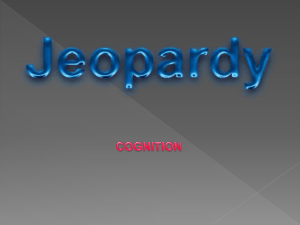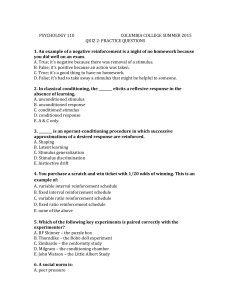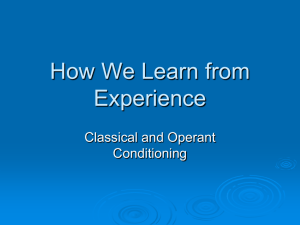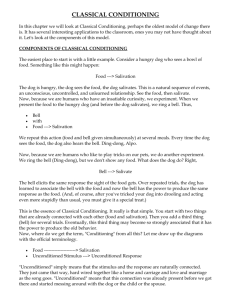Learning Theories Taught in EDFL 2240: Educational Psychology
advertisement
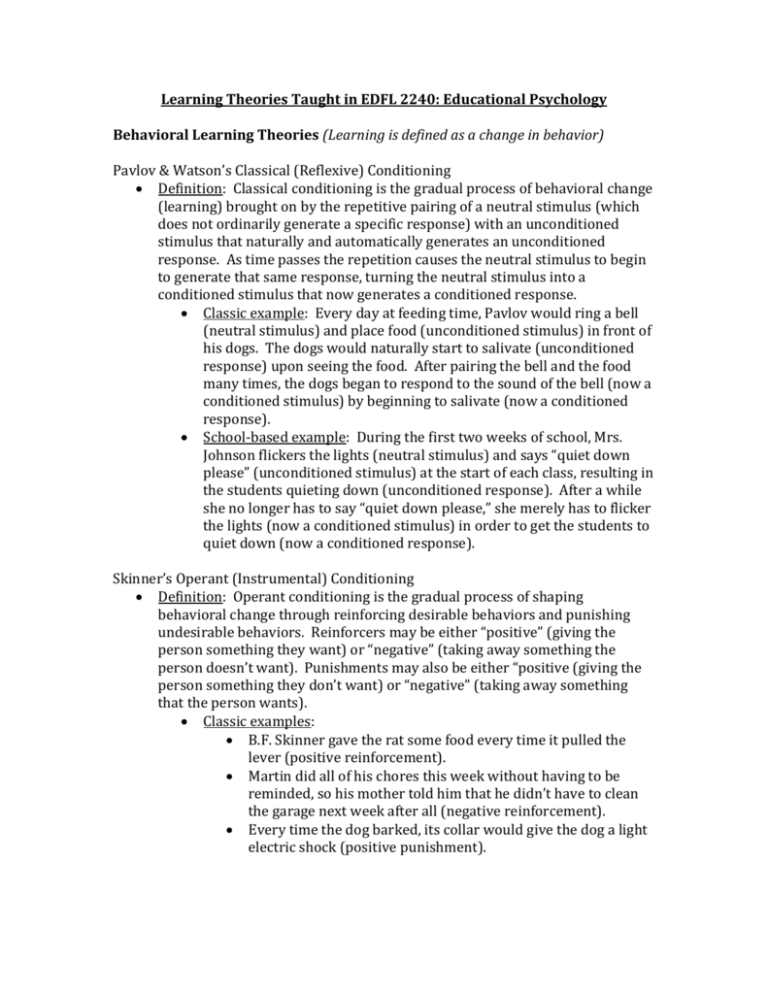
Learning Theories Taught in EDFL 2240: Educational Psychology Behavioral Learning Theories (Learning is defined as a change in behavior) Pavlov & Watson’s Classical (Reflexive) Conditioning Definition: Classical conditioning is the gradual process of behavioral change (learning) brought on by the repetitive pairing of a neutral stimulus (which does not ordinarily generate a specific response) with an unconditioned stimulus that naturally and automatically generates an unconditioned response. As time passes the repetition causes the neutral stimulus to begin to generate that same response, turning the neutral stimulus into a conditioned stimulus that now generates a conditioned response. Classic example: Every day at feeding time, Pavlov would ring a bell (neutral stimulus) and place food (unconditioned stimulus) in front of his dogs. The dogs would naturally start to salivate (unconditioned response) upon seeing the food. After pairing the bell and the food many times, the dogs began to respond to the sound of the bell (now a conditioned stimulus) by beginning to salivate (now a conditioned response). School-based example: During the first two weeks of school, Mrs. Johnson flickers the lights (neutral stimulus) and says “quiet down please” (unconditioned stimulus) at the start of each class, resulting in the students quieting down (unconditioned response). After a while she no longer has to say “quiet down please,” she merely has to flicker the lights (now a conditioned stimulus) in order to get the students to quiet down (now a conditioned response). Skinner’s Operant (Instrumental) Conditioning Definition: Operant conditioning is the gradual process of shaping behavioral change through reinforcing desirable behaviors and punishing undesirable behaviors. Reinforcers may be either “positive” (giving the person something they want) or “negative” (taking away something the person doesn’t want). Punishments may also be either “positive (giving the person something they don’t want) or “negative” (taking away something that the person wants). Classic examples: B.F. Skinner gave the rat some food every time it pulled the lever (positive reinforcement). Martin did all of his chores this week without having to be reminded, so his mother told him that he didn’t have to clean the garage next week after all (negative reinforcement). Every time the dog barked, its collar would give the dog a light electric shock (positive punishment). Janice came home two hours after curfew, so her parents took away her cell phone for one whole month (negative punishment). School-based examples: Frank received a gold-star sticker on his homework for getting all the answers correct (positive reinforcement). Mr. Jacobs rewards students with perfect attendance by letting them skip the final exam if they so choose (negative reinforcement). Lucy was given after-school detention for falling asleep in class (positive punishment). Ms. Bennett would make any student who played too roughly in her physical education class sit on the sidelines for five minutes instead of being able to continue playing (negative punishment). Social Learning Theories (Learning is defined as a change in behavior) Bandura’s Social Learning Theory Definition: Social learning is the process of changing one’s behavior (learning) as a result of observing the behavior of peers and role models and either mimicking them or intentionally doing something different. Classic examples: Bandura found that children who watched the video where the adult aggressively beat up the punching-bag “Bobo doll” toy were significantly more likely to act aggressively towards a similar doll themselves. Francine doesn’t actually like a certain style of clothes, but that look is really popular among her friends so she decides to dress that way anyway. Lenny’s older brother got in a lot of trouble when he was arrested for underage drinking, so Lenny has decided to wait until he is 21 to drink. School-based examples: Mr. Phillips doesn’t correct Jimmy when Jimmy calls out in class without raising his hand. Soon, other children in class are also calling out without raising their hands. Mrs. Baker demonstrates the process of long division on the board first, while her students watch her closely, before asking them to try what she did on their own. While most of her first-graders are slowly putting away their notebooks, Ms. Jacobs says “I love how Leah is already packed and standing quietly at the door to go to lunch.” The other first-graders quickly pack and rush over to get in line with Leah as well. Cognitive Science Learning Theories (Learning is defined as a change in thought) The Information Processing Model Definition: Modern cognitive psychology teaches that the thinking process involves three major components: The sensory memory, the short term (working) memory, and the long term memory. The sensory memory acts as a subconscious filter, becoming briefly aware of ALL information that your senses bring to the brain, and ultimately only allowing the tiny fraction of that information that it deems relevant to pass along to your short term memory. The short term (aka working) memory is the component of your memory that actively processes information on a conscious level, allowing you to make decisions and be aware of your thoughts. Only a tiny fraction of the information you think about with your short term memory gets passed along to the third stop, the long term memory. The long term memory is the mind’s permanent storage facility for information that it deems relevant, important, emotional, or meaningful enough to preserve for future use. As one thinks, information is constantly being pulled up from the long term memory for processing by the short term memory, before being stored in the long term memory again when your thoughts have again turned to something else. Major implications for teaching: Students should be encouraged to periodically pause during work to think about their thought processes and problem solving approaches in order to recognize when an approach is or isn’t working. Teachers should continually demonstrate the relevance of their content to students’ lives, as this will improve chances for long term recall. Teachers should always present information in an organized manner, with visual representations, diagrams, or models if possible. Teachers should always introduce new material by explaining how it ties in with previously taught content. Elaboration, the process of linking old and new information, greatly improves the chances that new information will be stored for long-term use. Students should be taught memory strategies to aid the short term memory (which is surprisingly bad in humans, actually) in learning new content, such as mnemonics, acronyms, rhymes or songs, etc. The Dual Code Theory Definition: Human memories may be encoded in a variety of sensory methods. We can have memories of things we heard, memories of visuals we saw, or even memories of a smell, taste, touch, etc. Research has strongly shown that the likelihood of a student learning and remembering something increases greatly if they are allowed to create memories with more than one sensory method (the more the better). School-based example: Allan’s teacher told him that pumice is a light, porous rock that forms when lava cools rapidly. Betsy’s teacher passed around a piece of pumice for the students to look at and said “This is pumice.” Carl’s teacher explained that pumice is a light, porous rock that forms when lava cools rapidly and passed around a piece for the students to examine. Carl will be significantly more likely to remember this information on a test than Allan or Betsy. Major implications for teaching: Teachers should use a variety of pedagogical methods, aimed at involving multiple senses. Teaching exclusively in one manner, such as lecture or video, is not recommended. Effective instruction should include a blend of lecture, imagery such as photos or videos, tactile stimulation such as hands-on activities, emotional experiences such as games or simulations, and other such diverse methods. The Levels of Processing Theory Definition: Experiments concerning thought and memory have shown that students are more likely to learn and remember information that is taught to them in a manner involving deep, complex processing rather than by using an easy, superficial task. Classic example: Researchers Craik and Tulving demonstrated that students are least likely to remember information about an item’s structure or appearance (“Was that word written in capital letters or lower-case letters?”), more likely to remember information about an item’s sound (“Did the word rhyme with cat?”), and most likely to remember information about an item’s meaning and associations to other material (“Does the word you saw make sense if put into this sentence?”) School-based example: Mr. Roberts makes his students copy each spelling word 20 times each. Ms. Yang makes her students write each spelling word in a sentence only two times. Mr. Roberts can’t figure out why Mrs. Yang’s students always win the school spelling bee. Major implications for teaching: Lessons should revolve around the usefulness and meaning of new concepts, skills, and information being learned. Rote memorization should be avoided, as should repetitionbased tasks that involve little thinking or attention. New information should be clearly connected to previously taught material, in order to maximize the formation of mental associations. Assignments should ask students to complete cognitively complex tasks rather than simple ones. Teachers should not shy away from teaching for depth rather than breadth. Teachers should encourage students to develop creative new ways to utilize the skills and information they are being taught.



